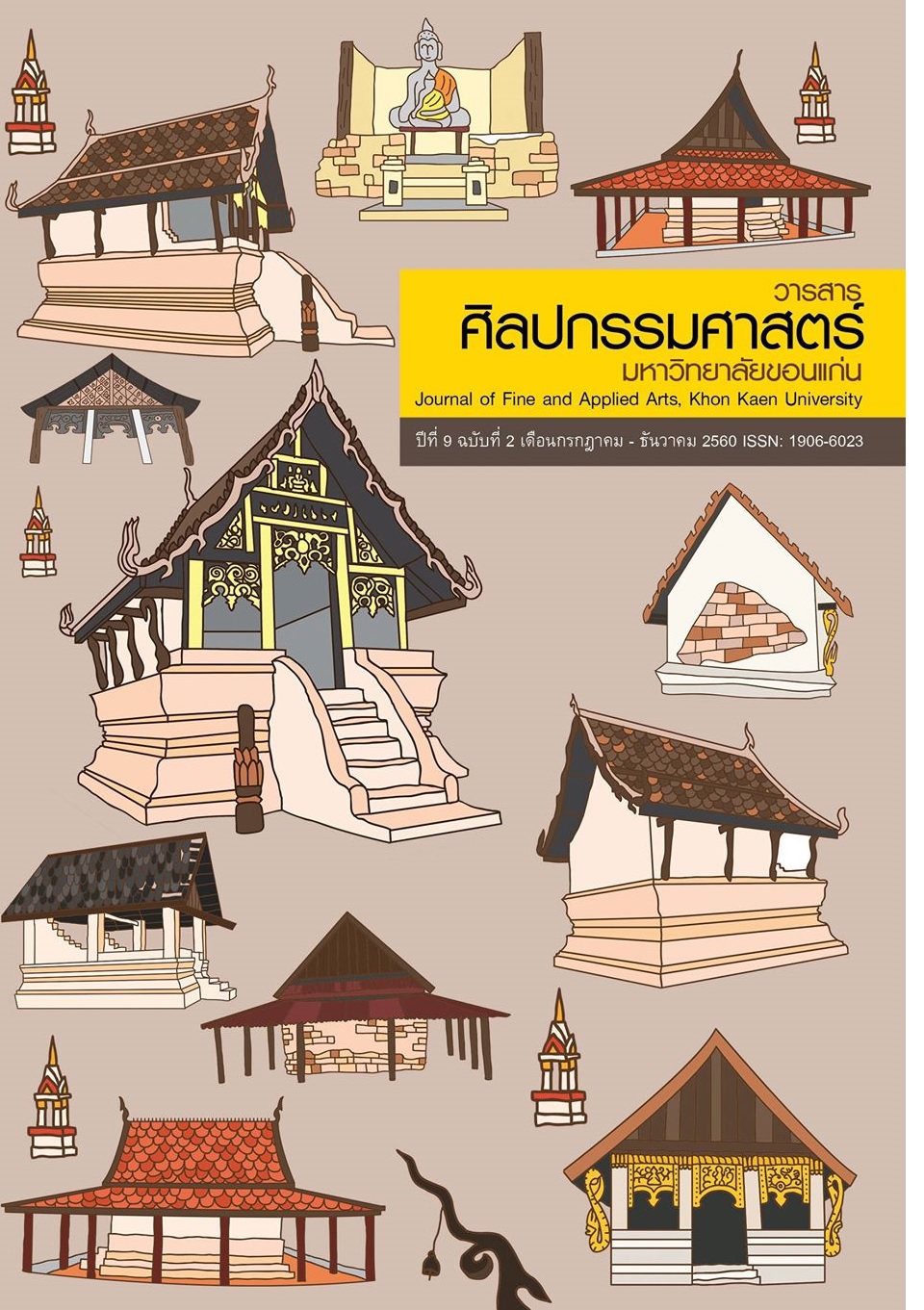กระบวนการสอนกีตาร์คลาสสิกของ อาจารย์เกียรติ เอกศิลป์ The Process of Classical Guitar Teaching of Kiat Akeasil
Main Article Content
บทคัดย่อ
กีตาร์คลาสสิกเป็นเครื่องดนตรีในตระกูลเครื่องสาย ด้วยเอกลักษณ์ทางเสียงที่นุ่มนวลไพเราะ แตกต่างไปจากเครื่องดนตรีประเภทอื่นๆ อีกทั้งบทเพลงสำหรับกีตาร์คลาสสิกมีระบบแบบแผนชัดเจน ในด้านคีตลักษณ์และวิธีการบรรเลงทั้ง ทำนอง (Melody) คอร์ด (Chord) และเบส (Bass) โดยผู้ที่เล่นกีตาร์คลาสสิกนั้นจะต้องใช้ทั้งความรู้ ทักษะและเทคนิคต่างๆอย่างเชี่ยวชาญ
การศึกษากระบวนการสอนกีตาร์คลาสสิกของอาจารย์เกียรติ เอกศิลป์ มีวัตถุประสงค์ของการวิจัยเพื่อศึกษากระบวนการสอนกีตาร์คลาสสิก หลักสูตรโดยศึกษา แนวคิดและหลักการสอน วิธีการสอน สื่อการสอน กิจกรรมเสริม การวัดผลประเมินผล เทคนิคการบรรเลงขั้นสูง ของอาจารย์เกียรติ เอกศิลป์ โดยใช้ระเบียบวิธีวิจัยเชิงคุณภาพ เก็บข้อมูลภาคสนามโดยการสัมภาษณ์ แบบมีโครงสร้างและไม่มีโครงสร้างใช้การสังเกตแบบมีส่วนร่วมและไม่มีส่วนร่วม และนำเสนอข้อมูลเชิงพรรณนาวิเคราะห์
ผลการวิจัยพบว่า กระบวนการสอนกีตาร์คลาสสิก เป็นการสอนตามความต้องการของผู้เรียนซึ่งการสอนจะมีอยู่ 2 กรณีคือ เพื่อเตรียมการแสดงคอนเสิร์ต (Recital Concert) และสอนหลักสูตรเพื่อใช้เตรียมสอบเกรด แนวคิดการสอนและวิธีการสอน อิงตามความต้องการของผู้เรียน โดยใช้จิตวิทยาถ่ายทอด และใช้หลักการประสบการณ์ที่มีการบรรยายสาธิตลำดับขั้นตอนเพื่อให้ผู้เรียนเข้าใจในกีตาร์คลาสสิกโดยสอนทฤษฏีดนตรีควบคู่กันไปกับปฏิบัติเมื่อเข้าใจทฤษฏีดนตรีแล้วจะทำให้ผู้เรียนมีความเข้าใจในบทเพลง สื่อและกิจกรรมเสริมเป็นตัวส่งเสริมให้การเรียนการสอนได้มีการพัฒนาในเรื่องทักษะปฏิบัติเพื่อให้การวัดผลประเมินผลของผู้เรียนใช้ความสามารถได้อย่างเต็มมีศักยภาพ กระบวนการสอนกีตาร์คลาสสิกเกิดขึ้นจากประสบการณ์และการพัฒนาตนเองอย่างต่อเนื่องของผู้สอนจนได้ค้นพบเทคนิคการบรรเลงขั้นสูงนั่นคือ 1) องค์ประกอบของการศึกษาบทเพลงของกีตาร์คลาสสิก 2) การศึกษาโดยใช้ตัวอย่างบทเพลง 3) เทคนิคการฝึกซ้อมเพลงเพื่อการจดจำบทเพลง ซึ่งเป็นเทคนิคการฝึกแยกส่วนในการฝึกซ้อมครั้งละ 20 นาที การปฏิบัติในท่อนเพลงจะเริ่มจากท้ายห้องจนมาถึงต้นห้องเพลง จากนั้นก็ทำการจดบันทึกการฝึกซ้อม เป็นกระบวนการสอนที่ส่งผลให้การเรียนการสอนประสบความสำเร็จได้ด้วยดี และฝึกซ้อมบทเพลงที่ดีและเหมาะสมในการถ่ายทอดความรู้แก่ผู้เรียนได้
Classical guitar is a string instrument. It has identity of soft sound, sweet tone, and difference from other instruments. Moreover, classical guitar songs are clarity pattern of form and style (Melody, Chord, and Bass) by using professional knowledge, skills and techniques of musician.
The purpose of this research is to learn teaching process of Classical guitar by Kiart Aekkasin (concept, principle, method, instruction media, sub-activity, evaluation, and advance technique) based on qualitative research. Data were collected by interview (structure and no structure) and observation (participation and no participation). They were presented by descriptive data.
The findings showed that teaching process of Classical guitar is requested by learners. It has 2 cases : preparation of Recital Concert and teaching for examination. Teaching concept and method based on learners request by using physiology and experience about step-by-step description. It makes learners to understand classic guitar by teaching theory and practicing together. Music theory will make learners understand lay, instruction media, and sub-activity (help leaner to develop practice skills) for measurement and evaluation well and potentially. Teaching process of Classic guitar caused by experience and self-development successively of instructors until they found advance techniques : 1) elements of study (guitar classic lay) 2) study of example music 3) practice technique to memorize music that is separate practice for 20 minutes. Performing in music will Begin with final bar to preliminary bar and then take notes practicing. It makes successful learning and teaching. Good and proper music practicing will make learners to develop more.
Article Details
เนื้อหาและข้อมูลในบทความที่ลงตีพิมพ์ในวารสารคณะศิลปกรรมศาสตร์ มหาวิทยาลัยขอนแก่น ถือเป็นความคิดเห็นและความรับผิดชอบของผู้เขียนบทความโดยตรง ซึ่งกองบรรณาธิการไม่จำเป็นต้องเห็นด้วย หรือร่วมรับผิดชอบใด ๆ
บทความ ข้อมูล เนื้อหา รูปภาพ ฯลฯ ที่ได้รับการตีพิมพ์ในวารสารคณะศิลปกรรมศาสตร์ มหาวิทยาลัยขอนแก่น ถือเป็นลิขสิทธิ์ของวารสารคณะศิลปกรรมศาสตร์ มหาวิทยาลัยขอนแก่น หากบุคคลหรือหน่วยงานใดต้องการนำทั้งหมดหรือส่วนหนึ่งส่วนใดไปเผยแพร่ต่อหรือเพื่อกระทำการใด ๆ จะต้องได้รับอนุญาตเป็นลายลักอักษรจากวารสารคณะศิลปกรรมศาสตร์ มหาวิทยาลัยขอนแก่น ก่อนเท่านั้น


